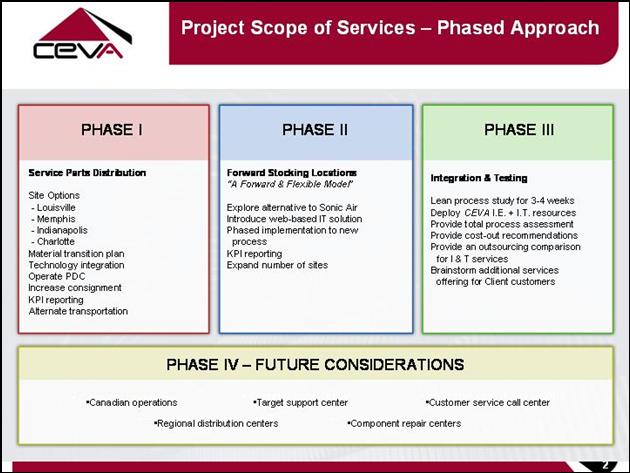CEVA – The Impact of Scale
Jacksonville, Florida USA
May 25, 2007
By
Richard Armstrong
Key Personnel:
David Kulik, CEO
Russ Dixon, Sr. Manager of Marketing & Communications
Keith Goldsmith, Sr. VP of Business Development & CIO
Marc Chrencik, Contract Manager
Terry Haber, Dir. of Sales & Marketing
CEVA is one of a handful of global supply chain management 3PLs. Most of its customers are among the world’s 200 largest companies. For them, CEVA provides a broad range of services. These services often start with demand planning. That is, the customer has given CEVA a schedule of what, how much, where and when product is needed. CEVA then notifies the producing vendor, monitors global transportation movement, manages handoffs of the product and manages the delivery to the proper destination in North America, Europe or Asia at the time required.
Strategic relationships are essential for CEVA’s global materials management. To make these supply chains work requires sophisticated IT and telecom capability, sufficient personnel strength around the world and in-depth knowledge of the customer’s business. That is, to manage global supply chains as CEVA does, requires scale. The 3PL’s who have this scale are multi-billion dollar transnational operations. They are citizens of the world.
CEVA’s scale includes 567 warehouses and distribution centers with 72 million square feet of space, 7,908 vehicles and 38,000 employees. CEVA has 1,200 contracts and $4.6 billion a year in revenue.
For comparison, GENCO, a well known North American value-added warehousing company and industry leader in return logistics, has 94 warehouses with over 30 million square feet, 6,000 employees, 50+ contracts and $571 million in revenues. GENCO is a very good 3PL, but it does not have the scale to do global material management.
CEVA’s IT excellence revolves around its globally linked network of locations using a web-based global event management system (GEMS), a robust order/transportation management system, a Tier 1 warehouse management system and a host of supporting IT. Visibility is available by order, shipment, SKU, truck route, warehouse location, country, event or yard location to name a few.
The key logistics management programs are in Jacksonville, Florida. They are fed data by global frame relay systems. The order management, TMS system incorporates and extends i2’s rate library and optimization tools. The multiple location WMS systems are Manhattan PkMS (U.S.) and RedPrairie (Europe). The name for the combined technology solutions is Matrix™.
Additional global data centers for the CEVA network are in Singapore and Amsterdam. The system backup center is in a specially fortified CSX building in Jacksonville.
Slightly less than 20% of CEVA’s business is in North America. Over 60% is in Europe. The remainder is in Asia and the rest of the world.
An advantage and strength of CEVA’s scale is the amount of intellectual capital it holds. Innovations and improvements occur more often because more people in a stimulated corporate culture are looking for them. In the long run, many heads are better than one.
CEVA’s innovation manifests itself in its sales. The strategic Development Process is a proactive sales approach. The approach gives customers a structured high-level, consultation about these operations. The process begins with an overall capabilities meeting followed by a “white board session” in which a high level look at the customer’s supply chain and opportunities for improvement are discussed. Two to three weeks after the “white board session” the customer is given a diagnostic report. Charges for this consulting process are minimal.

CEVA absorbs the cost and benefits from business improvements and good will. This “free consulting” service is limited to customers who have significant revenue potential. This practice is in keeping with CEVA’s emphasis on large, global accounts.
Like its global supply chain competitors, CEVA has a dozen or so accounts with more than $50 million per year in revenue. That scale and customer portfolio attracts a host of potential owners in today’s private equity rich markets.
CEVA was recently purchased by Apollo Management’s London office for $1.7 billion. The debt service portion is about $500 million.
CEO Dave Kulik told us CEVA is managing its debt service well. Growth and EBITDA improvement are expected. We surmise that Apollo will resell or take CEVA public in five years or so, making money primarily off growth and margin improvement.
For help with future challenges, Kulik has bolstered business development. Keith Goldsmith, who built the information network with its high level SCM components, has been promoted to Senior Vice President of Business Development. It is an interesting world in which the information management chief is the best qualified to make commitments to customers concerning their global needs.
Sources: A&A Primary Research, http://www.cevalogistics.com/


